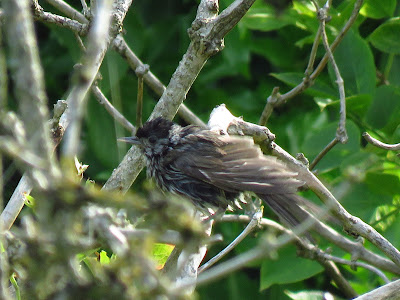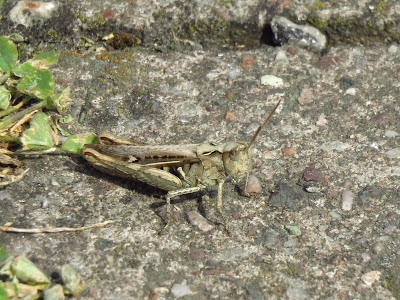
A sunny, warm morning, I looked forward to a visit to the patch, hoping in particular, to add Gatekeeper to the butterfly list. As I got to the patch boundary, 5-6 Swifts started chasing, trilling, low over the street.
I didn't have to wait long to see my first Gatekeeper, sunnying itself on the verges of the footpath by the drain.
Gatekeeper.
Speckled Wood.
Comma.
Green-veined White.
Nice to see just half a meter has been mowed on the sides of the footpath/cycle lane by Barmston drain, the verges are rich in wild plants and teeming with insects, including Small Tortoiseshell caterpillars (and I presume pupae) a good compromise between access and nature.
Two Small Tortoiseshell Caterpillars in search of fresh nettles.
Drinking and bathing
There appear to be a group of birds in a particular bush at the other side of the drain. They are a mixed bunch: Chiffchaff, Lesser Whitethroat, Wren, Robin, Blackbird, a family of Goldfinches, Woodpigeon and Dunnock. I think there might be a cat or another predator on the ground. I wait and keep identifying birds and adding them to my list, one of them is a young Sedge Warbler! the first one I actually see on the patch, I heard one singing earlier in the season. A bird, all soaked up, flies onto a branch to dry. They I think that the reason all these birds are there is that there might be a place where they can drink and bathe. It has been very dry in the last couple of weeks and the drain is not easy to access for a drink due to the marginal vegetation and how steep it is.
Lesser Whitethroat and Sedge Warbler.
Robin.
Young Sedge Warbler.
Lesser Whitethroat.
Soaking Blackcap.
Cemetery
In the Sculcoates N Cemetery a Southern Hawker is feeding on the main path, but almost immediately it stops hanging from a leaf, maybe it has hunted something as it seems to be holding something, maybe a moth?
There are many Gatekeepers and whites, but no Skippers. In a corner with Tansy, I search and find some Colletes bees, likely daviesanus.
Colletes on tansy.
In the Air Street cemetery, a Holly Blue flutters over a bed of ivy, but doesn't stop and flies high into the trees. I search for the small Elms growing in the corner, but since the last time I saw them a couple of weeks ago, one of them has died.
A woodpigeon struggling with a mishapen branch. It left it on the ground.
Before leaving I looked for dragonflies on the drain. An emperor and a Brown hawker were disputing a stretch of drain under the bridge. On the elevated ground, a Migrant hawker was hunting, and I was lucky as it stopped quite quickly for a rest, the first Migrant Hawker I photograph this year. I saw two others today. There seems to have been an influx in Hull in the last couple of days.
Migrant Hawker.
Brown Hawker over the drain.
Two species of grasshoppers on a small patch of brownfield with many wild carrots at Temple street.
Lesser Marsh Grasshopper, Chorthippus albomarginatus.
Common field grasshopper, Chorthippus brunneus.




















































